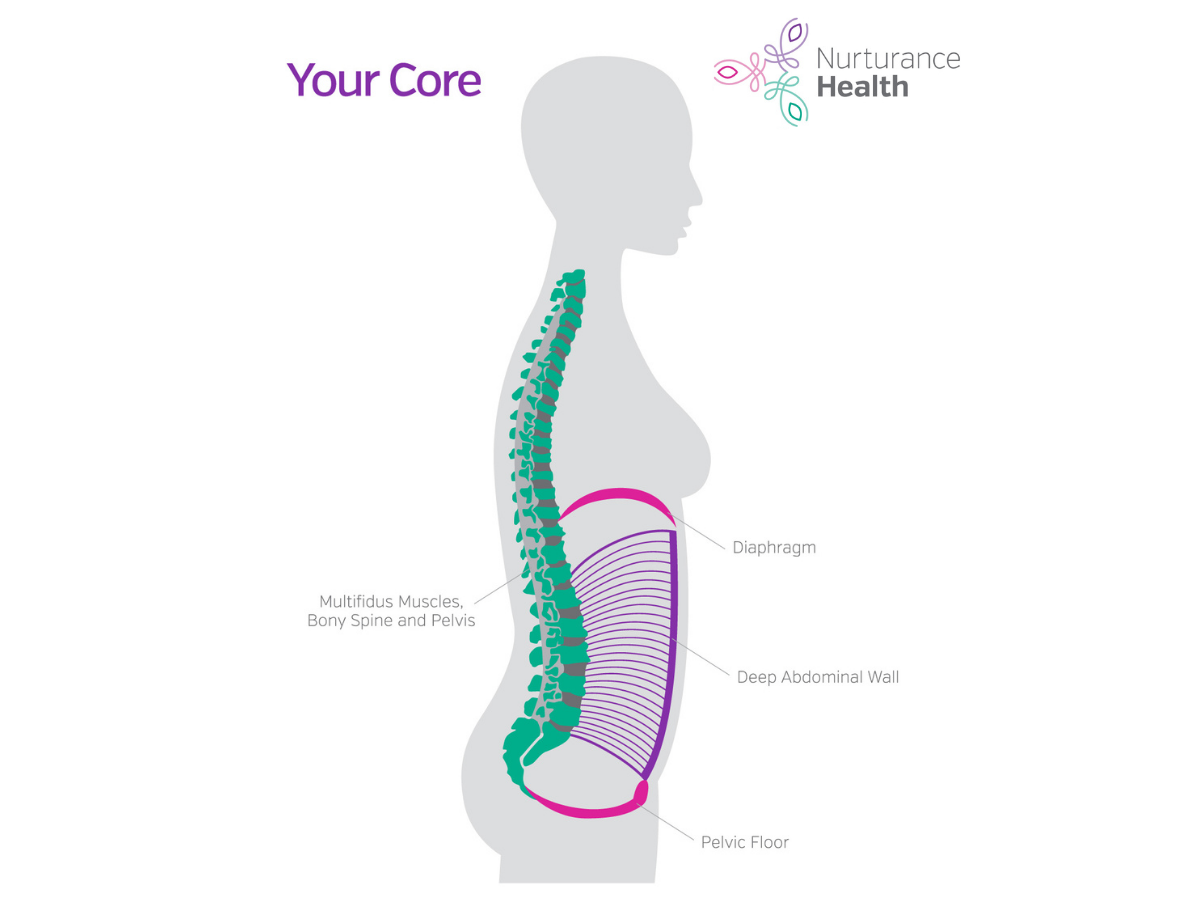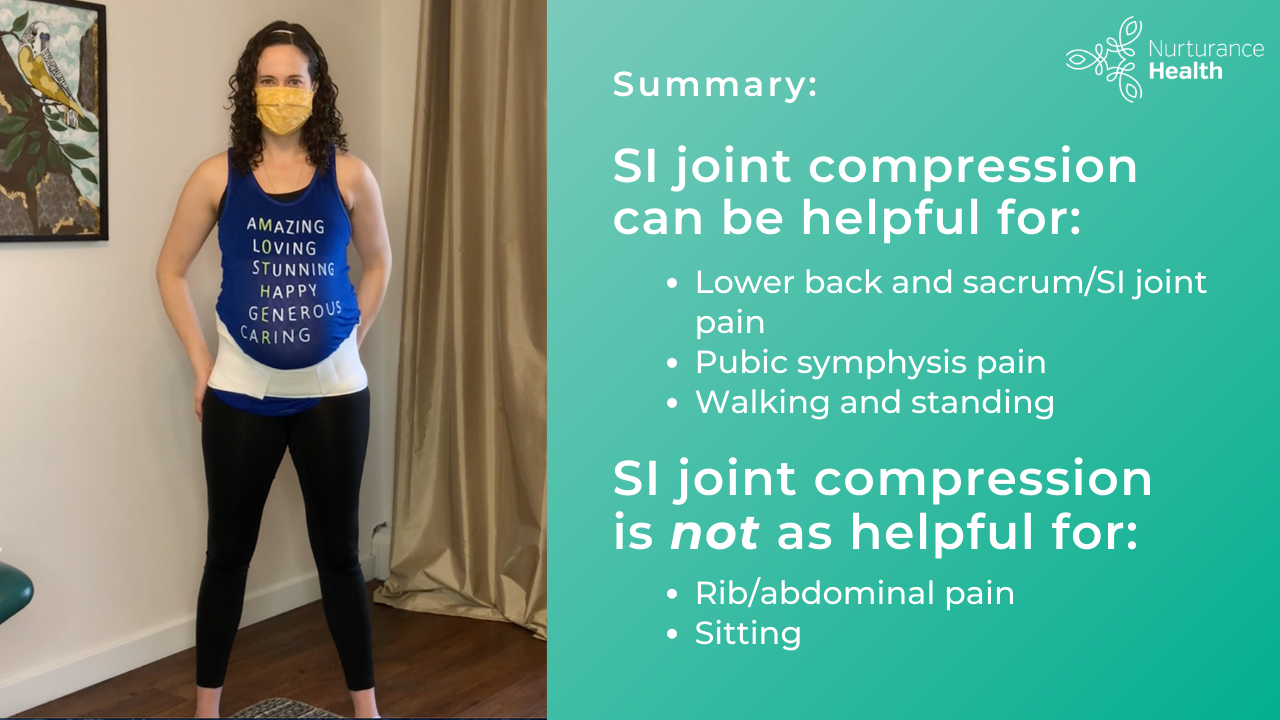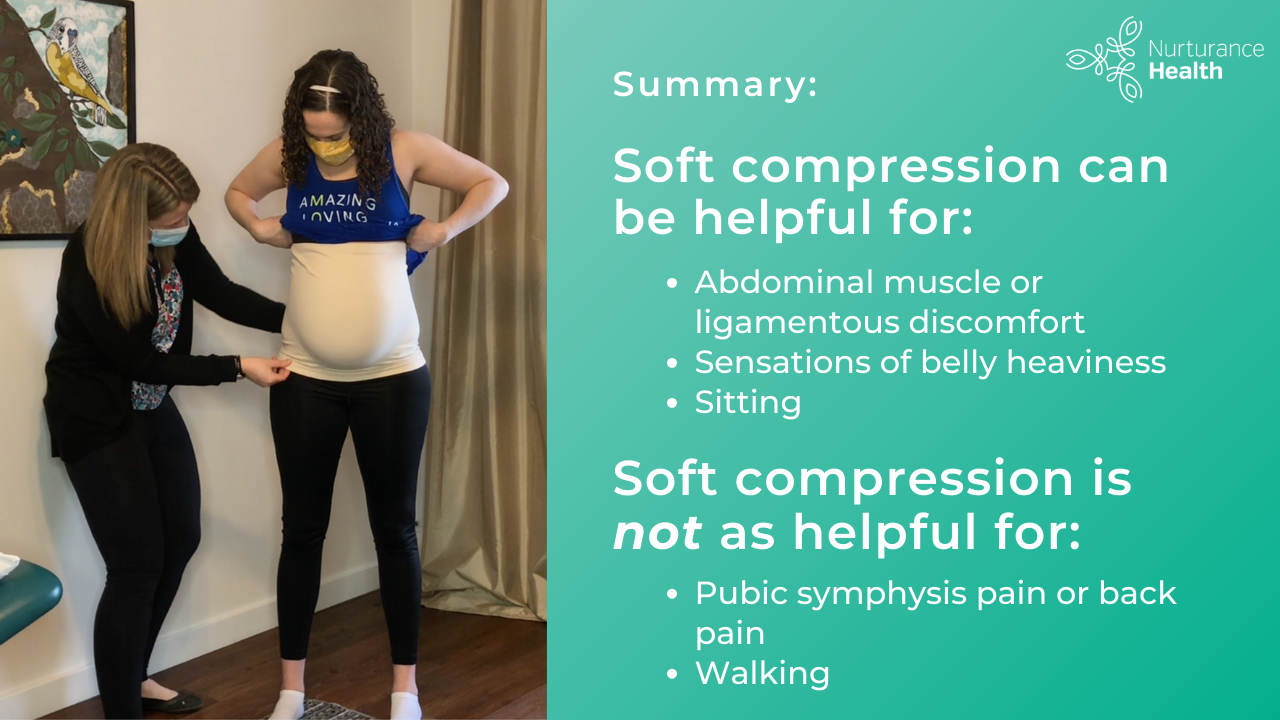Pregnancy Support Bands And Belts: Should You Wear One and Which Kind Is Best?
Do you need a pregnancy support belt or band?
In general, pregnancy support belts and bands have been designed (at the risk of sounding redundant) for support. Pregnancy can be challenging, with many aspects of your core canister experiencing biomechanical adaptations that aren’t easy. Your abdominal wall is lengthening to accommodate the growth of your baby, and your pelvic floor is weight lifting: it helps to carry your weight around, but also the weight of your amniotic fluid, your placenta and your baby – a baby which is ever increasing in size.

Check out our first video below to get started on whether or not a belt or band might be beneficial for you (or, if you prefer, read on below the video). The second and third videos on this page will also go into descriptions and instructions for wearing common kinds of belts and bands that are marketed for pregnancy support.
Not all people need support either! Pregnant people often feel well and support isn’t necessary, or sometimes a maternity support belt or garment actually might make things feel worse.
That being said, different people might benefit from support in different places. Generally, if a pregnancy support is going to be helpful, you should know nearly as soon as you put it on. When belts and garments are helpful, you have a sense of ease or aaahhhhhhh 😌 – right away. If it feels uncomfortable, that is valuable information from your body. You shouldn’t have to tough it out or “get used to it”.
Myths to dispell…
Another myth I want to dispel is that belts or supports will make you weak. There are no belts that could be physically strong enough to stop your muscles from working around their joints. Pregnancy is an extremely challenging biomechanical time for your core system, so adding some support isn’t going to make anything weak or reliant… the system is already really challenged. I’m also not aware of any scientific evidence to suggest using support during pregnancy can result in any negative kind of outcome.
There is a flipside to the research evidence though:
The current evidence doesn’t really support the usefulness of belts for pain during pregnancy.
That is something important to consider. It’s also another reason why not everyone needs a belt and why I don’t recommend them for everyone. Remember, pain can be complex. For more info on the potential influencing factors for pain during pregnancy, check out this article. And don’t forget, there are other tips that can be useful for managing pain during pregnancy and you can find some of them here.
However, in the clinic, I have seen belts and garments feel good and feel helpful for some people during pregnancy. In my opinion, the best thing to do is TEST IT OUT! Whenever possible, try the belt or band on that you are interested in – how does it feel? Test it out and be honest with yourself about whether or not its actually making a positive difference. What do you notice about your symptoms? How does it feel to move or stand or sit? Don’t be afraid to question.
You might also want to question what exactly that belt or band was meant to support. Let’s talk about some different options for support…
The SI Joint Compression Belt
The idea behind these belts is that they wrap around the bony ring of the pelvis; they should cover the SI joints in the back, and offer compression towards the pubic bone in the front. (Want to learn more about pelvic anatomy? Check out this blog post.) Because it offers support in multiple areas around the ring of the pelvis, this kind of belt can be helpful for people who are having lower back or SI joint and buttock pain, but also for those having pain in the front at the pubic symphysis.
Check out our next video or read on below to learn all about SI joint compression belts, how they can help, and how to put them on.
Remember that the pelvis does become more mobile during pregnancy but this is normal.
The pelvis does NOT become unstable during pregnancy.
It does not need to be held together. However, compression can often still feel good. There are probably a number of ways this belt could help people feel better, but I think the biggest reason is that it soothes the nervous system. This belt is like a big ol’ hug to your pelvis. 🤗
The video above is the best way to see how to put this belt on, but I want to point out a couple of common errors in how people use SI joint compression belts.
Tips for wearing SI joint compression belts:
2. Ideally, the belt should angle a little bit down towards the pubic bone, and they should have a cut out our change in shape for your baby and belly. Babies needs room to grow.
3. You also typically want to snug them up a fair bit. However, good belts are adjustable (and come in different sizeds), so you can experiment with how much compression feels best for you.
4. The belt should be positioned low as a first priority, but not low enough that it restricts you from lifting your leg when walking.
Is this belt for you?
If it feels good, then it might be a good support for you. I find these belts work the best for people who want or need to do a lot of standing or walking, or who are on their feet a lot during the day.
The drawback of this belt is that it is not comfortable in sitting. This kind of belt likely would not help someone who has pain while sitting to do computer work. It can feel too bulky and put too much pressure on your abdomen when you are sitting in it.
Since the sit-to-stand transition can often be painful during pregnancy, this belt can often help while you sit down, but then I recommend you just undo the Velcro. You can always do the Velcro back up before you stand up to go again.
We also don’t recommend sleeping in belts. However, you can typically wear them as much as you want during the day. The caveat here is that you should always clear the use of any kind support belt or band with your maternity care provider.

Maternity Support Bands
Another style of pregnancy support on the market is a soft-structured or cloth maternity band. This type of support tends to be lower profile, less bulky and more gentle. One perk to this type of band is that is often hides under clothing better and its flexibility is more comfortable in sitting. The drawback to this style of support is that because its softer, it doesn’t provide as much support or compression.
Check out the video below to learn all about maternity bands, when they can help, and how to put them on. You can also read on for more details too.
Is this kind of band for you?
Typically this style of support is meant more for the abdomen. I’ve found it can be useful for pregnant people who are experiencing abdominal discomfort like round ligament pain, or if there is discomfort higher in the abdominal muscles, or around the belly button (this can sometimes happen with the normal separation of the abdominal muscles that happens with pregnancy – diastasis recti – but not always). It can also help that feeling of belly “heaviness” that often shows up in the later stages of pregnancy too.
Although this kind of band is often touted to help your back, clinically I don’t find this style of support that helpful for lower back pain (a person could always test it though!). In addition, as far as I’m aware, there isn’t any research evidence to support the idea that wearing a maternity band could decrease your chance of developing a significant diastasis either. The use of maternity supports does not appear to be related to prevention when it comes to core canister challenges.
Another important note: abdominal support needs to have less compression than support for the pelvis. We don’t want heavy compression at the level of the abdomen because we don’t want any kind of pressure that could restrict uterine growth, or the growth of your baby.
How should you wear it?
Because they are soft, support bands therefore often don’t have robust Velcro or fasteners. Instead you step into them and pull them up over your abdomen (check out the video above for a visual). It’s often recommended they sit directly against your skin, rather than on top of your clothing.
The best bands for this kind of support should also offer graded compression. Graded means the compression is greatest towards the bottom of the support, but decreases as the support goes up to the rib cage (I also like maternity bands that offer more coverage from the hips all the way up to the bottom of the rib cage). Less compression is important at the rib cage so that it doesn’t interfere with your breathing. We always want to have as much freedom and ease as possible when it comes to breathing and the action of the diaphragm within our core canisters. You core canister is already adapting and changing to fit all of that growing baby!

Summary
Many people try out support bands and belts during pregnancy. You might have a friend who swears by the belt she used, and you may know of someone else who didn’t find bands helpful at all. Remember to think about the following questions if you are looking at maternity bands and belts:
- What was the belt/band/garment designed to support?
- What symptoms are you looking for help with?
- Be honest with yourself – how does it feel when its on?
Although there isn’t a magic one-sized-fits-all pregnancy belt or band that can help everyone, there might be one that is helpful for you. The best way to figure that out is to TEST IT!
Happy experimenting!
~Mandy
